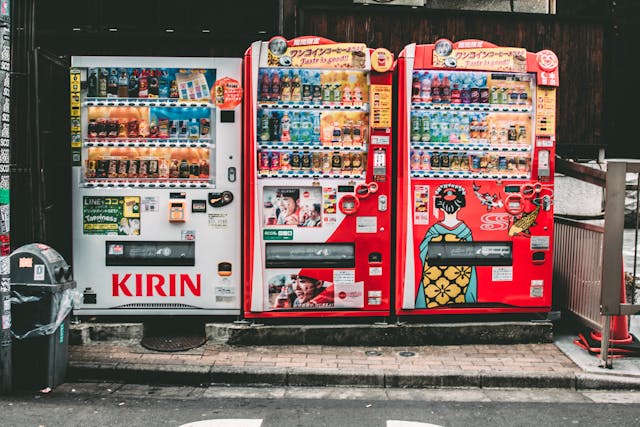
How do vending machines check money? They check notes with cameras or photocells. They check coins with electromagnets and light sensors. They are much more able to spot fake notes and coins than they used to be.
Early vending machines didn’t need to read banknotes because nothing that expensive was sold from them. The very first vending machines only took coins because paper money hadn’t even been invented then. The very first vending machine was invented in Greece in the 1st century AD. It dispensed holy water when someone put a coin in. The weight of the coin pulled down a dish, which opened a valve so the holy water could flow out. The dish was angled so that the coin fell off when it reached a certain point and the valve shut off.
Vending machines took off in the 19th century, almost two thousand years after that first one. By 1900, there were vending machines that sold newspapers, stamps, postcards, envelopes, chewing gum, chocolate, cigarettes, matches, and soap. All of these machines only needed coins and they sorted them by size. There was a shoot behind the slot you put the coin in and the coins rolled down that. The shoot had holes down it that corresponded to the size of the coins, from smallest to largest. The coins would roll over the smaller holes until they found the one that was its size and fell through, where they could be counted. This is simple, but it was very easy to fool because any piece of metal the same size as the coin will work.
Modern vending machines are much cleverer when it comes to scanning and checking coins. They check the coin’s dimensions, image, material, and weight before they accept them. If the coin fails any of these tests it will be rejected. Sometimes the reason is that the coin is dirty and simply wiping it will solve the problem, but it could be a fake coin. When you put a coin into the slot of the vending machine, it rolls onto a shoot. At the top of the shoot is a probe that creates a magnetic field which passes through the coin. All coins are made of different percentages of different metals and that alters the way they conduct a magnetic field. If the result doesn’t match any known coin, the coin will be rejected. The second detector is an optical laser that compares the image of that coin to all known coins in that currency. Then the coin drops down onto a weigher. The weighers have slots on them that are in order of the coin sizes, with the biggest at the top, so the coins can drop through to their specific weigher. The weigher is a lever with a counterweight and if the coin is the correct weight, it will lift the counterweight and the coin will be able to roll on. If your coin passed all of these things, it will be counted, and if it didn’t, it will be rejected.
Banknotes have always been more difficult to check and the first vending machine to take banknotes wasn’t created until the 1970s because nobody knew how to deal with the problem. The first vending machines that took banknotes checked them by using a magnet because banknotes are printed with magnetic ink. However, forgers learned how to make fake banknotes using magnetic ink and the vending machine companies had to up their game. These days, the vending machine checks the size of the banknote, the ink, the material of the paper, and the designs. When you put your banknote into the vending machine, the roller that pulls it in will also check the note’s dimensions. It has to be the correct width, but it also checks the thickness. The two rollers are charged and as the note moves them apart the voltage changes depending on the thickness of the note and the material it is made of. Then the note is magnetized to check the ink is the correct ink. Then an optical camera checks the design of the note against a database. It doesn’t just check the design, it zooms in to the pixel level because many banknotes are made with dots of a specific size. Then the machine shines a UV light on the banknote because many countries use a lot of symbols and systems in their notes that only show up under UV light. For example, US banknotes have a clear polyester thread embedded in the paper that has the denomination of the note written on it and each denomination glows a different color under UV light.
It is not impossible to fool a vending machine with fake money, but it is going to be pretty difficult. It is probably easier to go to a shop and try to fool a real person with the money. Or, just use real money. And this is what I learned today.
Photo by Louis: https://www.pexels.com/photo/a-photo-of-vending-machines-5881427/
Sources
https://web.mit.edu/2.972/www/reports/coin_tester/coin_tester.htm
https://en.wikipedia.org/wiki/Currency_detector
https://www.logicvending.co.uk/history-vending-machines
https://www.labroots.com/trending/videos/9684/here-s-how-vending-machines-know-when-coins-are-fake
